
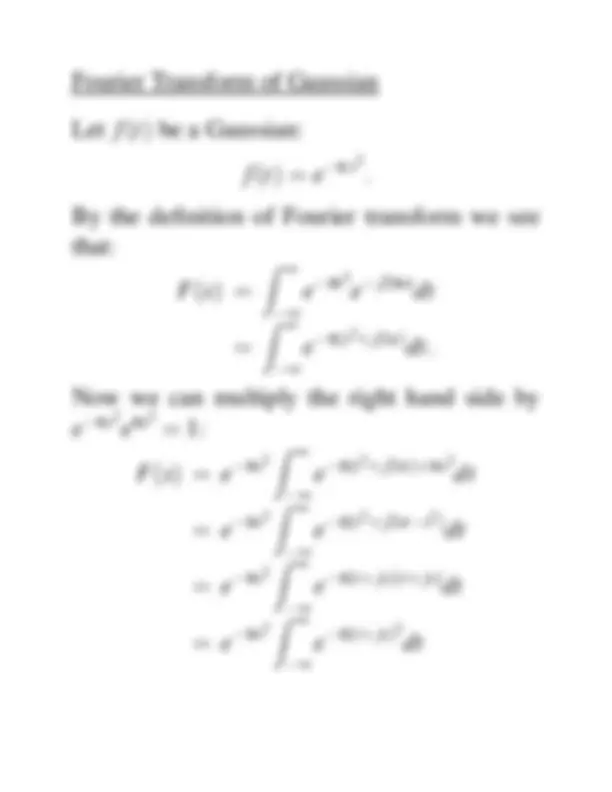
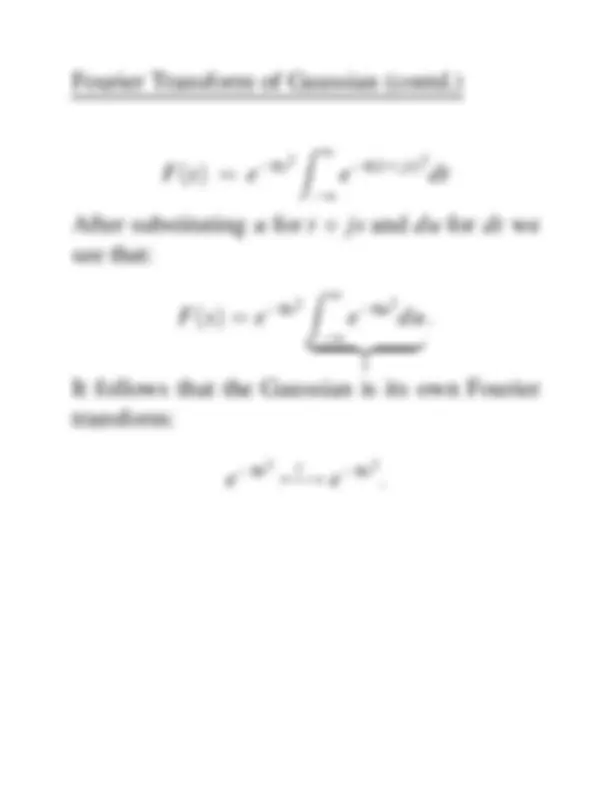
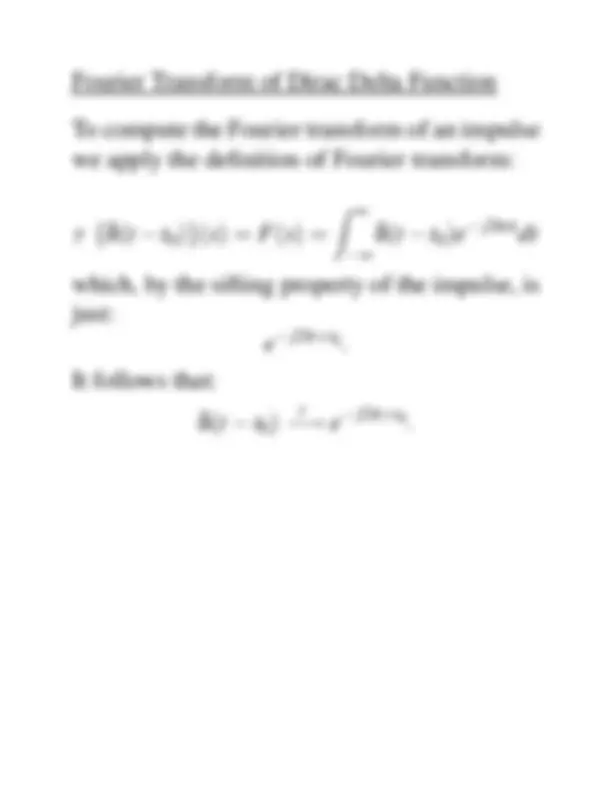
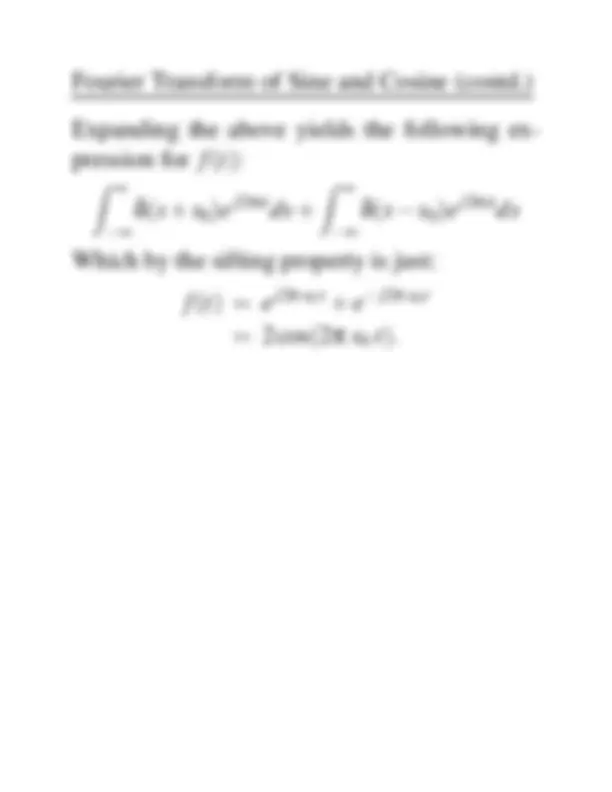
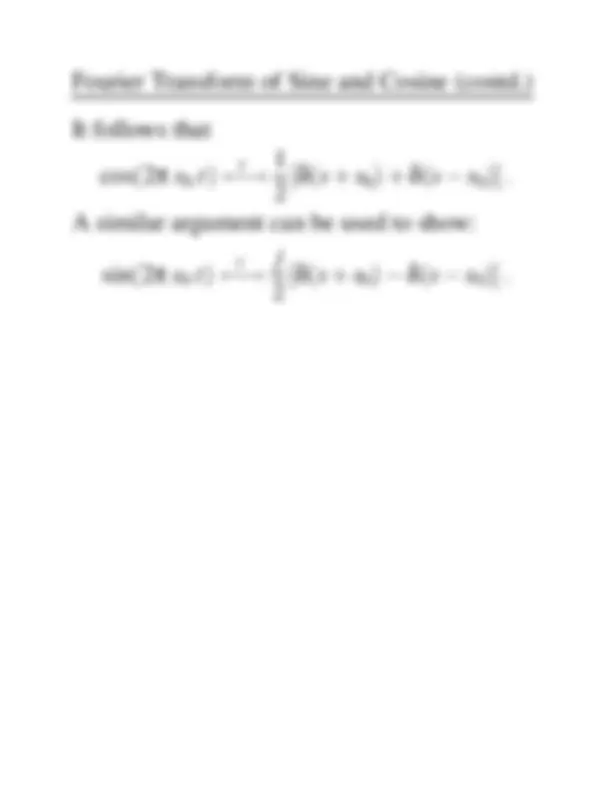
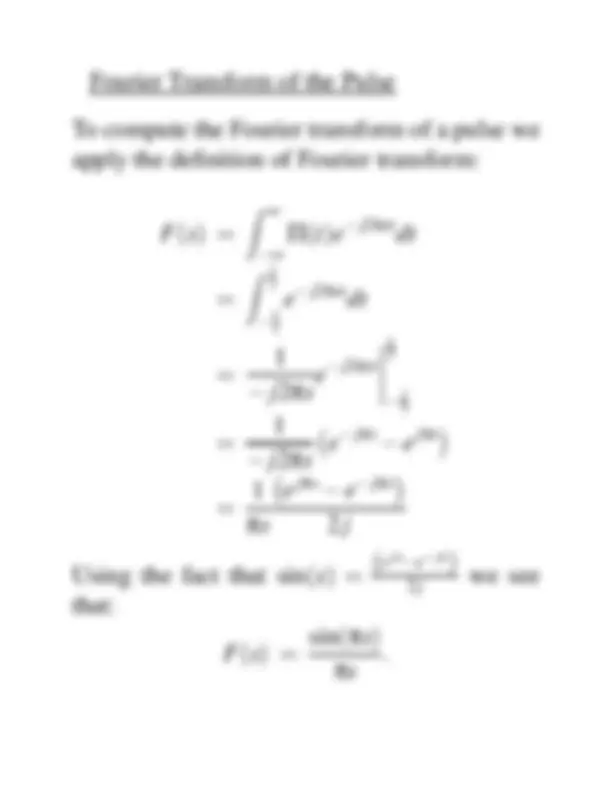


Study with the several resources on Docsity

Earn points by helping other students or get them with a premium plan


Prepare for your exams
Study with the several resources on Docsity

Earn points to download
Earn points by helping other students or get them with a premium plan
Community
Ask the community for help and clear up your study doubts
Discover the best universities in your country according to Docsity users
Free resources
Download our free guides on studying techniques, anxiety management strategies, and thesis advice from Docsity tutors
Fourier Transform Pairs. The Fourier transform transforms a function of time, f(t), into a function of frequency, F(s):. F {f(t)}(s) = F(s) = /.
Typology: Exams
1 / 12

This page cannot be seen from the preview
Don't miss anything!







Fourier Transform Pairs
The Fourier transform transforms a function of time, f (t), into a function of frequency, F(s):
F { f (t)}(s) = F(s) =
Z (^) ∞
−∞
f (t)e−^ j^2 πstdt.
The inverse Fourier transform transforms a func- tion of frequency, F(s), into a function of time, f (t):
F −^1 {F(s)}(t) = f (t) =
Z (^) ∞
−∞
F(s)e j^2 πstds.
The inverse Fourier transform of the Fourier trans- form is the identity transform:
f (t) =
Z (^) ∞
−∞
−∞
f (τ)e−^ j^2 πsτdτ
e j^2 πstds.
Fourier Transform Pairs (contd).
Because the Fourier transform and the inverse Fourier transform differ only in the sign of the exponential’s argument, the following recipro- cal relation holds between f (t) and F(s):
f (t) −→F F(s)
is equivalent to
F(t) −→F f (−s).
This relationship is often written more econom- ically as follows:
f (t) ←→F F(s)
where f (t) and F(s) are said to be a Fourier transform pair.
Fourier Transform of Gaussian (contd.)
F(s) = e−πs
2 Z (^) ∞
−∞
e−π(t+^ js)
2 dt
After substituting u for t + js and du for dt we see that:
F(s) = e−πs
2 Z (^) ∞
−∞
e−πu
2 du ︸ ︷︷ ︸ 1
It follows that the Gaussian is its own Fourier transform:
e−πt
(^2) F ←→ e−πs
2 .
Fourier Transform of Dirac Delta Function
To compute the Fourier transform of an impulse we apply the definition of Fourier transform:
F {δ(t − t 0 )}(s) = F(s) =
Z (^) ∞
−∞
δ(t − t 0 )e−^ j^2 πstdt
which, by the sifting property of the impulse, is just: e−^ j^2 π^ s t^0.
It follows that:
δ(t − t 0 ) F −→ e−^ j^2 π^ s t^0.
Fourier Transform of Sine and Cosine
We can compute the Fourier transforms of the sine and cosine by exploiting the sifting prop- erty of the impulse: Z (^) ∞
−∞
f (x)δ(x − x 0 )dx = f (x 0 ).
Z (^) ∞
−∞
[δ(s + s 0 ) + δ(s − s 0 )] e j^2 πstds.
Fourier Transform of Sine and Cosine (contd.)
Expanding the above yields the following ex- pression for f (t): Z (^) ∞
−∞
δ(s + s 0 )e j^2 πstds +
Z (^) ∞
−∞
δ(s − s 0 )e j^2 πstds
Which by the sifting property is just:
f (t) = e j^2 π^ s^0 t^ + e−^ j^2 π^ s^0 t = 2 cos( 2 π s 0 t).
Fourier Transform of the Pulse
To compute the Fourier transform of a pulse we apply the definition of Fourier transform:
F(s) =
Z (^) ∞
−∞
Π(t)e−^ j^2 πstdt
Z (^12)
−^12
e−^ j^2 πstdt
− j 2 πs
e−^ j^2 πst
(^12)
− j 2 πs
e−^ jπs^ − e jπs
πs
e jπs^ − e−^ jπs
2 j
Using the fact that sin(x) = (
e jx−e−^ jx) 2 j we see that:
F(s) =
sin(πs) πs
Fourier Transform of the Shah Function
Recall the Fourier series for the Shah function:
1 2 π
t 2 π
2 π
∞
ω=−∞
e jω^ t.
By the sifting property,
III
t 2 π
∞
ω=−∞
Z (^) ∞
−∞
δ(s − ω)e jstds.
Changing the order of the summation and the integral yields
III
t 2 π
Z (^) ∞
−∞
∞
ω=−∞
δ(s − ω)e jstds.
Factoring out e jst^ from the summation
III
t 2 π
Z (^) ∞
−∞
e jst^
∞
ω=−∞
δ(s − ω)ds
Z (^) ∞
−∞
e jstIII(s)ds.